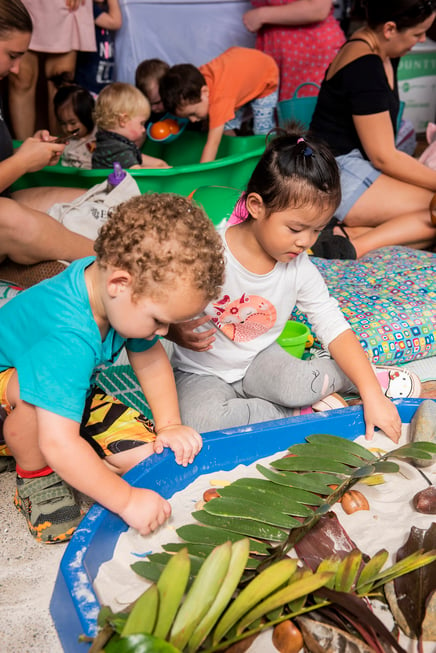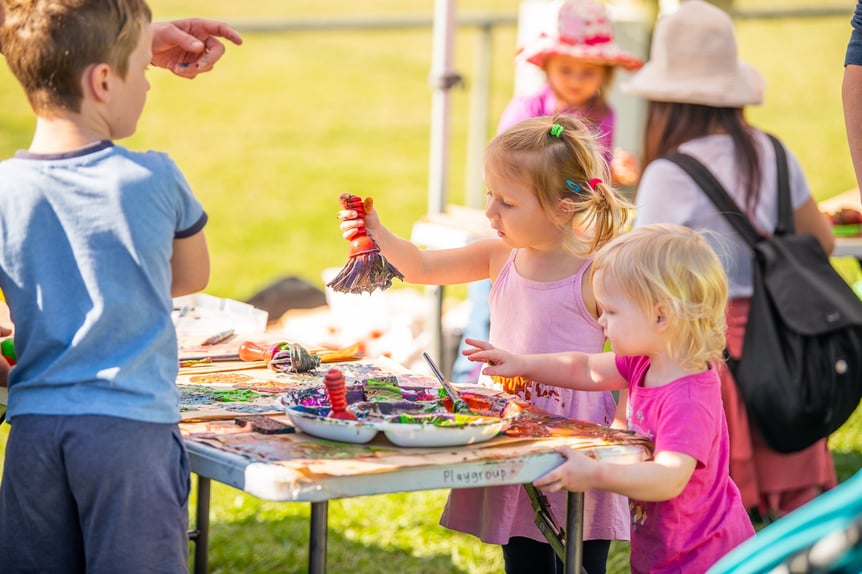Piaget's Theory of Cognitive Development (1983) outlines four stages of intellectual development:
- Sensorimotor (birth - 2 years old)
- Preoperational (2 - 7 years old)
- Concrete operational (7 - 11 years old)
- Formal operational (adolescence - adulthood)
In the sensorimotor stage, children get to know the world around them through movements and sensations, learning through basic actions such as sucking, grasping, looking, and listening. In the preoperational stage, children begin to think symbolically and learn to use words and pictures to represent objects and thoughts. In these two stages, experimental and explorative play is critical for a child’s development. Getting hands-on and messy gives children opportunities to develop a range of skills.

Why is it important?
Messy play provides opportunities for children to develop both fine and gross motor skills. Running hands through sand, mud, and rice provides tactile input. Using fingers and hands promotes finger strength, grasping and dexterity, which lay the foundation for handwriting or operating tools like scissors. Incorporating big body movements such as walking through sand and water promotes a sense of balance and body awareness, and enhances gross motor skills.
Messy play provides naturalistic opportunities to teach social and emotional skills. Over-aroused children can melt away their excitement and anger by repetitively running their hands through sand and rice. Repetitive movements and appropriate sensory inputs put our body back into a state of mindfulness. It is like pressing the reset button. Once children are calmer, it gives carers the opportunity to talk about how the child feels and what happened to make them anxious. It provides a rich learning experience for children to develop self-awareness and develop an understanding of their emotions.
Messy play is also a great tool to encourage children to work together, especially for children who may struggle to play in group environments.

Where can you do it?
If your child has sensory processing difficulties, don’t overwhelm them with too many options or textures. This may lead to sensory overload and cause a meltdown, which is the complete opposite to what you want to achieve.
Start off with a quieter environment. For example, go to the beach in the afternoon. It will be less bright, less busy, have less traffic and less noise from people. Your child can focus on the experience of walking through sand, touching rocks and feeling the wind. Starting simple is the key.
What do you need?
Children who have sensory processing difficulties have strong preferences on tactile input because of their hypersensitivity to textures. Try to progress the tactile input in stages. Always begin with the least amount of tactile input, completely dry materials are the best. Dried beans, uncooked rice, dried leaves, feathers and sand are good examples for dry materials.
Gradually move on to the next category, which are materials with mild tackiness. Cooked pasta, play dough, moon sand and water beads are good examples. The last stage is to encourage messy play. Slime, wet paint, shaving foam and mud are intense textures for many children, so leave these to last.
.jpg?width=1532&name=PLAY%20MATTERS%20(56).jpg)
Tips to get children involved:
Give children lots of options and alternatives. Prepare a bin full of tools, such as spare gloves, tongs, and scoops. Encourage children to try to participate in messy or sensory play first using tools, then move toward physically touching the materials.
Provide children with lots of positive affection. Every time they try to touch something new and exciting, show your support by saying something like, “I can see you are giving it a try! How does the sand feel in your hands?”. This reinforces your appreciation of their effort. You are also providing a valuable opportunity for children to connect with their senses. Children should never be forced to touch anything they do not wish to touch. Also, get creative and get outside. Messy play should not cost anything. Find opportunities to do messy experiences in nature. The smell of trees and grass is very calming.
References:
Piaget, J. (1983). Piaget’s theory. P. Mussen (ed). Handbook of Child Psychology. 4th edition. Vol. 1. New York, NY: Wiley.
Miller, K. R. S., & Metz, A. E. (2012). Pretending enhances engagement in messy play for children with sensory sensitivity. Journal of Occupational Therapy, Schools, & Early Intervention, 5(3-4), 259-274. doi: 10.1080/19411243.2012.744653
Gascoyne, S. (2019). Messy Play in the Early Years. London: Routledge, https://doi.org/10.4324/9781351234702
.jpg?width=352&name=PLAY%20MATTERS%20(57).jpg)

.jpg)


.jpg)
